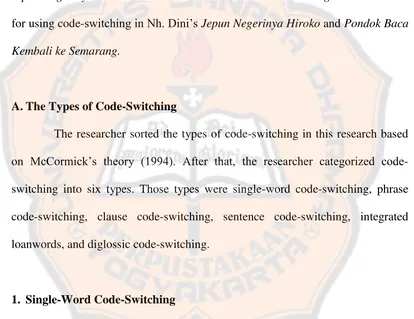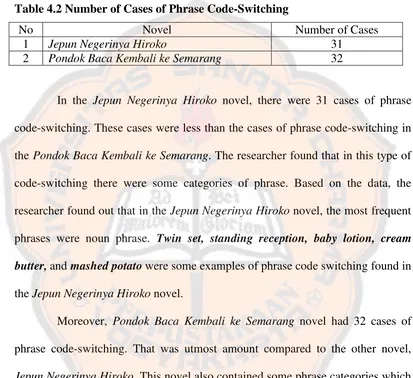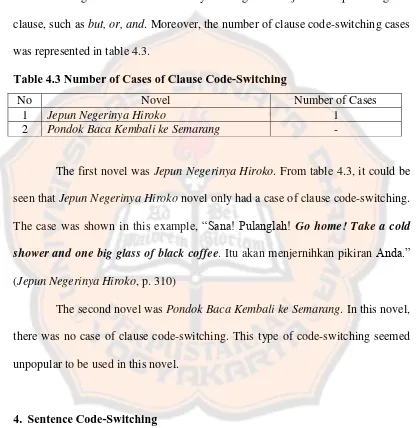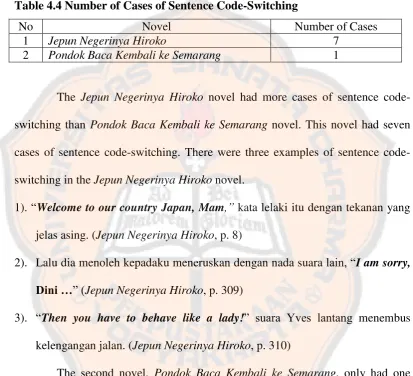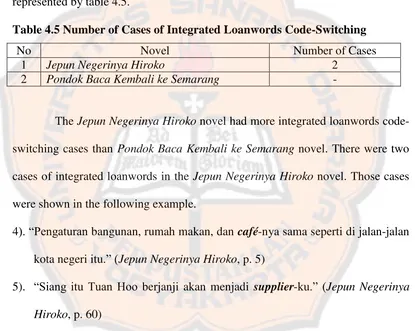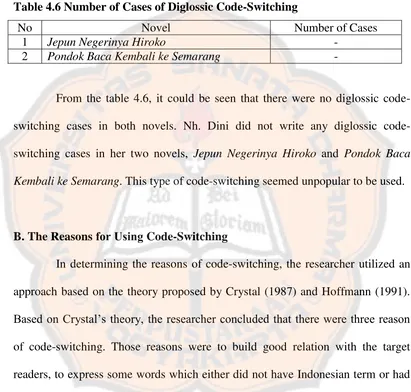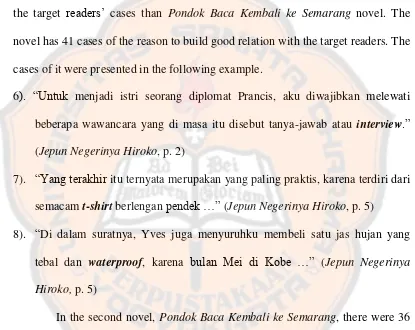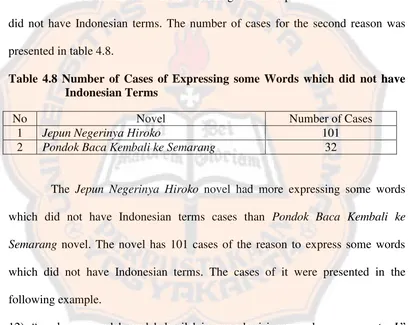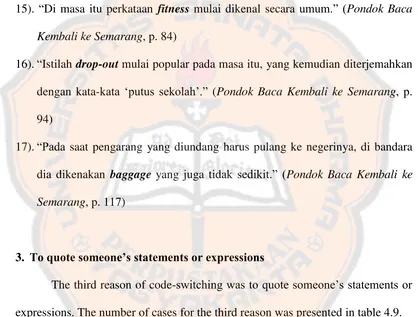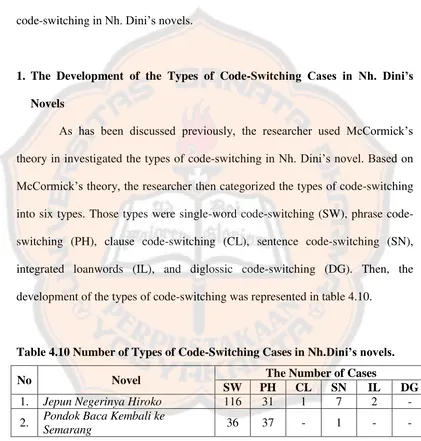vii ABSTRACT
Permatasari, Fransisca Galih. (2014). Code-switching in N.H. Dini’s Jepun Negerinya Hiroko and Pondok Baca Kembali ke Semarang. Yogyakarta: English Language Education Study Program, Sanata Dharma University.
When bilingual or multilingual people communicate with each other, some sociolinguistic cases such as code-switching will rise up. Regarding the cases, this study was conducted to investigate the use of code-switching in N.H. Dini’s Jepun Negerinya Hiroko and Pondok Baca Kembali ke Semarang. The two novels were chosen due to the need for measuring the development of the use code-switching in N.H. Dini’s novels.
The research has two research problems to be answered, namely 1) What are the types of code-switching found in Nh. Dini’s Jepun Negerinya Hiroko and Pondok Baca Kembali ke Semarang? and 2) What are the reasons for using code-switching in Nh. Dini’s Jepun Negerinya Hiroko and Pondok Baca Kembali ke Semarang? Thus, there are two main objectives in this research. First, it aims to observe the types of code-switching found in N.H. Dini’s Jepun Negerinya Hiroko and Pondok Baca Kembali ke Semarang. Second, it attempts to find out the reasons for code-switching in N.H. Dini’s Jepun Negerinya Hiroko and Pondok Baca Kembali ke Semarang. Those two objectives lead the researcher to reveal the development of the use of code-switching in N.H. Dini’s novels.
Since the research provided an in-depth description of a certain phenomenon, the qualitative approach was used as the nature of the research. Content analysis was conducted as the method in the study since it analyzes the types and reasons of code-switching in N.H. Dini’s Jepun Negerinya Hiroko and Pondok Baca Kembali ke Semarang. Further, the researcher also applied the descriptive approach in which the final results of this research were intepreted in the form of description.
The findings of the research showed that the most dominant type found in Nh. Dini’s Jepun Negerinya Hiroko and Pondok Baca Kembali ke Semarang was single-word code-switching. There were 65.80% single-word code-switching cases of English code-switching in Nh. Dini’s two novels. However, there was no diglossic code-switching cases in those two novels. On the other hand, there were two common reasons for code-switching found in Nh. Dini’s Jepun Negerinya Hiroko and Pondok Baca Kembali ke Semarang. Those were to build good relation with the target readers and to express some words which either did not have Indonesian term or had Indonesian term but they were rarely used. However, there were only 3.89% of English code-switching in Nh. Dini’s two novels whose reason was to quote someone’s statements or expressions.
viii ABSTRAK
Permatasari, Fransisca Galih. (2014). Code-switching in N.H. Dini’s Jepun Negerinya Hiroko and Pondok Baca Kembali ke Semarang. Yogyakarta: Pendidikan Bahasa Inggris, Universitas Sanata Dharma.
Ketika orang-orang penutur bilingual maupun multilingual berkomunikasi, beberapa kasus sosiolinguistik seperti alih kode akan muncul. Berkenaan dengan permasalahan tersebut, penelitian ini diadakan untuk menginvestigasi penggunaan alih kode dalam novel karya N.H. Dini yang berjudul Jepun Negerinya Hiroko dan Pondok Baca Kembali ke Semarang. Dua novel ini dipilih berdasarkan kebutuhan untuk mengukur perkembangan penggunaan alih kode pada novel-novel karya N.H. Dini.
Penelitian ini memiliki dua permasalahan yang harus dijawab, yaitu 1) Apa saja tipe-tipe alih kode yang terdapat pada novel karya Nh. Dini yang berjudul Jepun Negerinya Hiroko and Pondok Baca Kembali ke Semarang? dan 2) Apa saja alasan-alasan alih kode yang terdapat pada novel karya Nh. Dini yang berjudul Jepun Negerinya Hiroko and Pondok Baca Kembali ke Semarang? Maka dari itu, penelitian ini memiliki dua tujuan utama. Tujuan yang pertama adalah untuk meninjau tipe-tipe alih kode yang terdapat dalam novel Jepun Negerinya Hiroko dan Pondok Baca Kembali ke Semarang karya N.H. Dini. Tujuan yang kedua adalah untuk mencari alasan-alasan penggunaan alih kode dalam novel Jepun Negerinya Hiroko dan Pondok Baca Kembali ke Semarang karya N.H. Dini. Kedua tujuan tersebut berguna untuk mengungkapkan perkembangan penggunaan alih kode dalam novel karya N.H. Dini.
Penilitian ini memberikan deskripsi mendalam mengenai suatu fenomena, maka dari itu peneliti menggunakan pendekatan kualitatif. Metode analisa isi diadakan karena penelitian ini bertujuan menganalisa berbagai tipe dan alasan penggunaan alih kode pada novel karya N.H. Dini, Jepun Negerinya Hiroko dan Pondok Baca Kembali ke Semarang. Lebih jauh lagi, peneliti juga menggunakan pendekatan deskriptif dimana hasil akhir dalam penelitian ini diintepretasikan dalam suatu deskripsi.
Hasil dari penelitian ini menunjukkan bahwa tipe paling dominan pada novel karya Nh. Dini, Jepun Negerinya Hiroko and Pondok Baca Kembali ke Semarang adalah single-word code-switching. Terdapat 65.80% kasus single-word code-switching dalam kedua novel karya N.H. Dini tersebut. Akan tetapi tidak ditemukan adanya kasus diglossic code-switching pada kedua novel tersebut. Di sisi yang lain, ada dua alasan umum alih kode yang terdapat pada kedua novel karya N.H. Dini tersebut. Kedua alasan tersebut adalah untuk membangun relasi yang baik dengan pembaca dan untuk mengungkapkan beberapa kata yang tidak memiliki istilah dalam bahasa Indonesia atau memiliki istilah dalam bahasa Indonesia tetapi jarang digunakan. Akan tetapi, hanya ada 3.89% kasus alih kode dalam bahasa Inggris pada kedua novel N.H. Dini yang alasannya adalah untuk mengutip pernyataan dan ungkapan seseorang.
CODE
-
SWITCHING IN N.H. DINI’S JEPUN NEGERINYA HIROKO
AND PONDOK BACA KEMBALI KE SEMARANG
A SARJANA PENDIDIKAN THESIS
Presented as a Partial Fulfillment of the Requirements to Obtain the Sarjana Pendidikan Degree
in English Language Education
By
Fransisca Galih Permatasari Student Number: 091214094
ENGLISH LANGUAGE EDUCATION STUDY PROGRAM DEPARTMENT OF LANGUAGE AND ARTS EDUCATION FACULTY OF TEACHERS TRAINING AND EDUCATION
i
CODE-SWITCHING IN N.H. DINI
’S
JEPUN NEGERINYA HIROKO
AND PONDOK BACA KEMBALI KE SEMARANG
A SARJANA PENDIDIKAN THESIS
Presented as a Partial Fulfillment of the Requirements to Obtain the Sarjana Pendidikan Degree
in English Language Education
By
Fransisca Galih Permatasari Student Number: 091214094
ENGLISH LANGUAGE EDUCATION STUDY PROGRAM DEPARTMENT OF LANGUAGE AND ARTS EDUCATION FACULTY OF TEACHERS TRAINING AND EDUCATION
iv This thesis is dedicated to:
Papa and Mama
, for their unconditional love, care, and support.For I know the thoughts that I think toward you, says the Lord, thoughts of peace and not of evil, to give you a future and a hope. (Jeremiah 29: 11, NKJV)
vii ABSTRACT
Permatasari, Fransisca Galih. (2014). Code-switching in N.H. Dini’s Jepun Negerinya Hiroko and Pondok Baca Kembali ke Semarang. Yogyakarta: English Language Education Study Program, Sanata Dharma University.
When bilingual or multilingual people communicate with each other, some sociolinguistic cases such as code-switching will rise up. Regarding the cases, this study was conducted to investigate the use of code-switching in N.H. Dini’s Jepun Negerinya Hiroko and Pondok Baca Kembali ke Semarang. The two novels were chosen due to the need for measuring the development of the use code-switching
in N.H. Dini’s novels.
The research has two research problems to be answered, namely 1) What are the types of code-switching found in Nh. Dini’s Jepun Negerinya Hiroko and Pondok Baca Kembali ke Semarang? and 2) What are the reasons for using
code-switching in Nh. Dini’s Jepun Negerinya Hiroko and Pondok Baca Kembali ke Semarang? Thus, there are two main objectives in this research. First, it aims to observe the types of code-switching found in N.H. Dini’s Jepun Negerinya Hiroko and Pondok Baca Kembali ke Semarang. Second, it attempts to find out the reasons for code-switching in N.H. Dini’s Jepun Negerinya Hiroko and Pondok Baca Kembali ke Semarang. Those two objectives lead the researcher to reveal the development of the use of code-switching in N.H. Dini’s novels.
Since the research provided an in-depth description of a certain phenomenon, the qualitative approach was used as the nature of the research. Content analysis was conducted as the method in the study since it analyzes the types and reasons of code-switching in N.H. Dini’s Jepun Negerinya Hiroko and Pondok Baca Kembali ke Semarang. Further, the researcher also applied the descriptive approach in which the final results of this research were intepreted in the form of description.
The findings of the research showed that the most dominant type found in
Nh. Dini’s Jepun Negerinya Hiroko and Pondok Baca Kembali ke Semarang was single-word code-switching. There were 65.80% single-word code-switching cases of English code-switching in Nh. Dini’s two novels. However, there was no diglossic code-switching cases in those two novels. On the other hand, there were two common reasons for code-switching found in Nh. Dini’s Jepun Negerinya Hiroko and Pondok Baca Kembali ke Semarang. Those were to build good relation with the target readers and to express some words which either did not have Indonesian term or had Indonesian term but they were rarely used. However, there were only 3.89% of English code-switching in Nh. Dini’s two novels whose
reason was to quote someone’s statements or expressions.
viii ABSTRAK
Permatasari, Fransisca Galih. (2014). Code-switching in N.H. Dini’s Jepun Negerinya Hiroko and Pondok Baca Kembali ke Semarang. Yogyakarta: Pendidikan Bahasa Inggris, Universitas Sanata Dharma.
Ketika orang-orang penutur bilingual maupun multilingual berkomunikasi, beberapa kasus sosiolinguistik seperti alih kode akan muncul. Berkenaan dengan permasalahan tersebut, penelitian ini diadakan untuk menginvestigasi penggunaan alih kode dalam novel karya N.H. Dini yang berjudul Jepun Negerinya Hiroko dan Pondok Baca Kembali ke Semarang. Dua novel ini dipilih berdasarkan kebutuhan untuk mengukur perkembangan penggunaan alih kode pada novel-novel karya N.H. Dini.
Penelitian ini memiliki dua permasalahan yang harus dijawab, yaitu 1) Apa saja tipe-tipe alih kode yang terdapat pada novel karya Nh. Dini yang berjudul Jepun Negerinya Hiroko and Pondok Baca Kembali ke Semarang? dan 2) Apa saja alasan-alasan alih kode yang terdapat pada novel karya Nh. Dini yang berjudul Jepun Negerinya Hiroko and Pondok Baca Kembali ke Semarang? Maka dari itu, penelitian ini memiliki dua tujuan utama. Tujuan yang pertama adalah untuk meninjau tipe-tipe alih kode yang terdapat dalam novel Jepun Negerinya Hiroko dan Pondok Baca Kembali ke Semarang karya N.H. Dini. Tujuan yang kedua adalah untuk mencari alasan-alasan penggunaan alih kode dalam novel Jepun Negerinya Hiroko dan Pondok Baca Kembali ke Semarang karya N.H. Dini. Kedua tujuan tersebut berguna untuk mengungkapkan perkembangan penggunaan alih kode dalam novel karya N.H. Dini.
Penilitian ini memberikan deskripsi mendalam mengenai suatu fenomena, maka dari itu peneliti menggunakan pendekatan kualitatif. Metode analisa isi diadakan karena penelitian ini bertujuan menganalisa berbagai tipe dan alasan penggunaan alih kode pada novel karya N.H. Dini, Jepun Negerinya Hiroko dan Pondok Baca Kembali ke Semarang. Lebih jauh lagi, peneliti juga menggunakan pendekatan deskriptif dimana hasil akhir dalam penelitian ini diintepretasikan dalam suatu deskripsi.
Hasil dari penelitian ini menunjukkan bahwa tipe paling dominan pada novel karya Nh. Dini, Jepun Negerinya Hiroko and Pondok Baca Kembali ke Semarang adalah single-word code-switching. Terdapat 65.80% kasus single-word code-switching dalam kedua novel karya N.H. Dini tersebut. Akan tetapi tidak ditemukan adanya kasus diglossic code-switching pada kedua novel tersebut. Di sisi yang lain, ada dua alasan umum alih kode yang terdapat pada kedua novel karya N.H. Dini tersebut. Kedua alasan tersebut adalah untuk membangun relasi yang baik dengan pembaca dan untuk mengungkapkan beberapa kata yang tidak memiliki istilah dalam bahasa Indonesia atau memiliki istilah dalam bahasa Indonesia tetapi jarang digunakan. Akan tetapi, hanya ada 3.89% kasus alih kode dalam bahasa Inggris pada kedua novel N.H. Dini yang alasannya adalah untuk mengutip pernyataan dan ungkapan seseorang.
ix
ACKNOWLEDGEMENTS
It has been up and down that I had to face during the process of completing this thesis. I believe this work would not have finished without support and help from the people around me. So here I am giving my gratitude and thankfulness to each person who strengthens me in the long-winded journey to achieve my Sarjana Pendidikan degree.
First of all, I would like to express my greatest gratitude to Jesus Christ for His never ending love and grace. I thank Him for the health and every single thing that He has prepared for me.
I would like to express my earnest thanks to my advisor, Drs. Barli Bram, M.Ed., Ph.D., who has patiently given me part of his precious time to read, correct, and improve my thesis. I am deeply grateful for his suggestion, advice, and assistance in every part of my study during the completion of this thesis.
My gratitude also goes to all lecturers of the English Language Education Study Program who have given me valuable and everlasting knowledge during my study. The same expression goes to the secretariat staff of the English Language Education Study Program for helping me in the administration procedure.
x
brothers, Rizerius Galih Rakasiwi and Graceus Galih Ravindra, for being my spirit when I was down.
I would like to thank Diyonisius for being a good listener, great motivator, and great partner in happiness and sorrows. I thank him for his care, support, and attention. He encouraged and asked me to never stop trying when I was falling.
My thankfulness goes to all friends of ELESP batch 2009 class B, especially Dani’, Hana, Sinta, Hans, Cha-cha ‘Solo’, Mas Anggit, Agnes, and Alice, for the great time we share. I thank ELEGY and LEATHER, for the great process and togetherness we have passed. My thanks also go to my best friend, Awa Merdiani for always supporting me. I would like to express my overwhelming thanks to my best motivator ever, Jan Patrick Ostrowski for supporting and asking me for always be an optimist person.
Last but not least, I would like to thank everybody whose name cannot be mentioned one by one, for their support and prayers so that I can finish this thesis. May Jesus Christ grant them peace, joy, and happiness.
xi
TABLE OF CONTENTS
TITLE PAGE ... i
APPROVAL PAGES ... ii
DEDICATION PAGE ... iv
STATEMENTS OF WORK’S ORIGINALITY ... v
PERNYATAAN PERSETUJUAN PUBLIKASI ... vi
ABSTRACT ... vii
ABSTRAK ... viii
ACKNOWLEDGEMENTS ... ix
TABLE OF CONTENTS ... xi
LIST OF TABLES ... xiii
LIST OF APPENDICES ... xiv
CHAPTER I: INTRODUCTION ... 1
A. Research Background ... 1
B. Research Problem ... 3
C. Problem Limitation ... 3
D. Research Objectives ... 4
E. Research Benefits ... 4
F. Definition of Terms ... 5
CHAPTER II: REVIEW OF RELATED LITERATURE ... 8
A. Theoretical Description ... 8
xii
CHAPTER III: RESEARCH METHODOLOGY ... 18
A. Research Method ... 18
B. Research Subject ... 19
C. Research Instrument ... 21
D. Data Gathering Technique ... 21
E. Data Analysis Technique ... 22
F. Research Procedure ... 23
CHAPTER IV: RESEARCH RESULT AND DISCUSSION ... 24
A. The Types of Code-Switching ... 24
B. The Reasons for Using Code-Switching ... 31
C. The Development of the Use of Code-Switching ... 35
CHAPTER V: CONCLUSIONS AND RECOMMENDATIONS ... 42
A. Conclusions ... 42
B. Recommendations ... 44
REFERENCES ... 46
APPENDICES ... 49
xiii
LIST OF TABLES
4.1 Number of Cases of Single-Word Code-Switching ... 25
4.2 Number of Cases of Phrase Code-Switching ... 27
4.3 Number of Cases of Clause Code-Switching ... 28
4.4 Number of Cases of Sentence Code-Switching ... 29
4.5 Number of Cases of Integrated Loanwords Code-Switching ... 30
4.6 Number of Cases of Diglossic Code-Switching ... 31
4.7 Number of Cases of Building Good Relation with the Target Reader ... 32
4.8 Number of Cases of Expressing some Words which did not have Indonesian Terms ... 33
4.9 Number of Cases of Quoting Someone’s Statements or Expressions ... 34
4.10 Number of Types of Code-Switching Cases in Nh.Dini’s novels. ... 36
4.11 Number of Reasons for Using Code-Switching in Nh. Dini’s novels ... 39
A.1. Types of Code-Switching in Jepun Negerinya Hiroko ... 54
A.2. Types of Code-Switching in Pondok Baca ... 67
B.1. Reasons for Using Code-Switching in Jepun Negerinya Hiroko ... 76
B.2. Reasons for Using Code-Switching in Pondok Baca ... 87
C.1. Summarized Data of the Types of Code-Switching ... 93
xiv
LIST OF APPENDICES
Appendix 1 (An Overview of Nh. Dini) ... 50
Appendix 2 (The Synopsis of Jepun Negerinya Hiroko) ... 51
Appendix 3 (The Synopsis of Pondok Baca Kembali ke Semarang)... 53
Appendix 4 (Types of Code-Switching in Jepun Negerinya Hiroko) ... 54
Appendix 5 (Types of Code-Switching in Pondok Baca) ... 67
Appendix 6 (Reasons of Code-Switching in Jepun Negerinya Hiroko) ... 76
Appendix 7 (Reasons of Code-Switching in Pondok Baca) ... 87
Appendix 8 (Summarized Data of the Types of Code-Switching) ... 93
1 CHAPTER I
INTRODUCTION
This chapter presents the research background, research problem, problem limitation, research objective, reseach benefits, and definitions of terms. The research background consists of the researcher’s reasons for choosing the topic. The research problem deals with the main problem or the main point that the researcher wants to deeply uncover. The problem limitation is the limitation of the problem in this research, so it will not be too broad. The research objective is about the reason why this research was conducted. The research benefits deals with the beneficial effect for the English Language Education Study Program students, readers, and other researchers. The definition of terms deals with the definition of terms related to this research.
A. Research Background
2 novels were chosen because N.H. Dini’s novels contain a lot of cases of code-switching that the researcher wants to measure.
The researcher chose Nh. Dini’s novels to be observed since Nh. Dini is a
popular novelist in Indonesia. Besides, she had ever lived abroad for many years. Due to those reasons, the researcher wanted to know how big the effects of being a multilingual person for Nh. Dini to her work, especially her style of writing. The researcher also chose the two novels of Nh. Dini which were published in different years since she wanted to investigate whether there were some developments of the use of code-switching or not. She also wanted to know whether the settings of the country in the novel influenced the use of code-switching or not. Therefore, the researcher chose Jepun Negerinya Hiroko novel which was published in 2000 and Pondok Baca Kembali ke Semarang novel which was published in 2011. Jepun Negerinya Hiroko novel’s setting is abroad, mostly in Japan, while Pondok Baca Kembali ke Semarang novel’s setting is in Indonesia, especially in Semarang, Central Java.
One interesting language feature that can be found in novels is the prominent alternation of words, phrases, or even sentences from English put together with Indonesian to construct interesting language expression. For example, the word shopping is used frequently in novels. In fact, in Indonesian language, people can say belanja but Indonesians tend to use the word shopping than the word belanja.
within sentences, involving phrases or words or even parts of words” (Spolsky, 1998). People often switch between the two languages in the middle of their conversation. Code switching also often happens in the written texts.
Based on the phenomenon above, the researcher would like to focus her attention on the development of the use of code-switching in Nh. Dini’s Jepun Negerinya Hiroko and Pondok Baca Kembali ke Semarang. The researcher wants to investigate the types of code-switching found in Nh. Dini’s Jepun Negerinya Hiroko and Pondok Baca Kembali ke Semarang and the reasons for using code-switching in Nh. Dini’s Jepun Negerinya Hiroko and Pondok Baca Kembali ke Semarang.
B. Research Problem
This research aims to answer two main problems. The two main problems are stated as follows:
1. What are the types of code-switching found in Nh. Dini’s Jepun Negerinya Hiroko and Pondok Baca Kembali ke Semarang?
2. What are the reasons for using code-switching in Nh. Dini’s Jepun Negerinya Hiroko and Pondok Baca Kembali ke Semarang?
C. Problem Limitation
4 Negerinya Hiroko and Pondok Baca Kembali ke Semarang. This research involves the switching between Indonesian and English language. In addition, it is limited to observe two of Nh. Dini’s memory series novels, Jepun Negerinya Hiroko and Pondok Baca Kembali ke Semarang. This decision was based on the need to adequate data and time efficiency consideration.
D. Research Objectives
This research aims to answer the problem formulation as follows:
1. To observe the types of code-switching found in Nh. Dini’s Jepun Negerinya Hiroko and Pondok Baca Kembali ke Semarang.
2. To find out the reasons for using code-switching in Nh. Dini’s Jepun Negerinya Hiroko and Pondok Baca Kembali ke Semarang.
E. Research Benefits
This research is expected to give contributions to the English Language Education Study Program students, readers, and other researchers.
1. English Language Education Study Program Students
2. Readers
First, the research may expectantly give the readers who learn English as a second language to know whether the use of code-switching can either help or hinder learning. Second, it is expected that this research will also enrich the readers to have broader knowledge of the common phenomenon that occurs around them, that is code-switching.
3. Other researchers
The researher also hopes that this study will enable the other researchers to have a further study of code-switching. In addition, this study is expected to inspire other researchers to conduct research on the other language phenomena which exist in society.
F. Definition of Terms
In order to get better understanding, the researcher clarifies some words which have become the main idea of this research. These are:
1. Code switching
6 language to Indonesian language context in Indonesian novels, Jepun Negerinya Hiroko and Pondok Baca Kembali ke Semarang.
2. Memory Series Novels
Nh. Dini wrote many novels, such as memory series novels. There were around 12 novels which are included in memory series novels. They were Sebuah Lorong di Kotaku (1978), Pada Ilalang di Belakang Rumah (1979), Langit dan
Bumi Sahabat Kami (1979), Sekayu (1981), Kuncup Berseri (1982), Kemayoran
(2000), Jepun Negerinya Hiroko (2000), Dari Parangik ke Kampuchea (2003),
Dari Fontenay ke Magallianes (2005), La Grande Bourne (2007), Argenteuil:
Hidup Memisahkan Diri (2008), and Pondok Baca Kembali ke Semarang (2011). The stories in Nh. Dini’s memory series novels were continuous. These novels told about Dini’s life from her youth until her old age.
3. Jepun Negerinya Hiroko
The Jepun Negerinya Hiroko novel was published in 2000. It is one of the memory seriesnovels written by Nh. Dini. The setting of place of this novels was abroad, mostly in Japan. Besides Japan, there were some other setting of places like Hongkong, Kampuchea, and Indonesia. The characters in this novels were mostly educated men. Since Dini was married to Yves Coffin, a French diplomat, therefore she met a lot of Yves’ colleagues who were all educated.
4. Pondok Baca Kembali ke Semarang
8 CHAPTER II
REVIEW OF RELATED LITERATURE
This chapter will discuss some theories used in the research. The theories are used to support the research. This chapter aims to give basic principles related to the formulated problems. This chapter consists of two major sections, theoretical description and theoretical framework. The theoretical description will give explanation of theoretical review related to code-switching. In addition, the theoretical framework will discuss the theories that are used as the framework of this research.
A. Theoretical Description
This section will elaborate some theories. The theories that will be elaborated are sociolinguistics, code switching, and brief descriptions of Nh. Dini’s memory series novels.
1. Sociolinguistics
According to Lehman (1972), sociolinguistics is the study of the use of language in society. There are some factors that influence the use of language in society. One of those factors is bilingualism. Bilingualism is when a person has a tendency to use more that one language to communicate with others. One of the common products of bilingualism is code-switching.
In the condition of bilingualism, people will often alter language or language style. Bilingualism depends on the condition and the needs of using the language itself. As an example, when a speaker uses “A” language to talk with a second speaker. Afterwards, a third speaker who is not able to use “A” language comes and joins the conversation situation. Therefore, the first speaker switched into “B” language which is understandable by the third speaker. In this situation
code-switching is employed. Code-switching has a significant relevance to sociolinguistics.
10 2. Code-switching
Asher (1994)states that “the term “code” refers to variety of a language.” Asher defined code switching as the switching from one variety to another, either of the same language or of different languages, in speech or writing.
There are some different arguments which were proposed by linguists in order to define the terms code-switching and borrowing. Some linguistics differentiate these two terms. However, many linguists tend to see that code-switching and borrowing as a continuum. In this research, the researcher sees code-switching as similar process. It has been supported by Rezaeian (2009: 16) views that “code-switching and borrowing have similar processes which fall along a single continuum”
a. The Nature of Code-Switching
According to Gardner (1997: 36), code-switching can be defined as “the use of two or more languages in the same conversation or utterance” Such kind of behavior occurs in situations where the people are bilingualism or multilingualism, situations of immigrations, and regional minorities. Therefore, code-switching is a common thing in the society. Gardner adds that behavior involved in the phenomenon relies on the sociolinguistics circumstances and the language combination as well.
Gardner’s idea is supported by Wardaugh (2010: 103) who states that “utilizing several varieties of any languages they speak is a common thing found
people who live in a multilingual country have the tendency to choose the varieties or codes they want to talk with.
Hoffmann (1991: 110) states that the wide-ranging description of code-switching is that “it involves the alternate use of two languages or linguistics
varieties within the same utterance or during the same conversation.” She adds that the switching could consist of changing languages. Bilinguals are typically able to switch their language. She also adds that older people have capability in controlling the amount of code-switching they do rather than younger people. Some factors influence how they switch their language, such as contextual, situatioal, and personal factors.
From the point of view of some linguists previously, it can be concluded that code-switching is the language’s change in the same utterances. Additionally, the switching can be in the primary utterance, in the middle utterance, or in the last utterance.
b. The Types of Code-Switching
12 the switching carried a particular evocative purpose for example, speaking about a place in the variety which is used there, it is called metaphorical switching” (Gardner, 1997). “A possible reason in distinguishing those different types of code-switching is that they tend to occur in the same context and often involve the same speakers” (1997: 361). Instead of that, speakers also involve two varieties of language in order to preserve their monolingual character. This type of code-switching is called code-mixing. Gardner (1997) cites from Harmers and Blanc (1989) that this code-mixing term is sometimes called as interference.
Hoffmann (1991) illustrates some evidence that there are many types of code-switching. From the examples she has made, she concludes that the first type of code-switching is occured when the switching is within the sentence or it is called intra-sentential switches. Second, the switches happen between sentences or inter-sentential switches. The third is called emblematic switching. This type includes items such as tags or exclamations which serve as an emblem of the bilingual character. Moreover, the last type of switching involves a change of pronunciation feature. Those types typically occur at the phonological level.
According to McCormick (1994), as cited in Asher’s Encyclopedia of
Single-word code-switching is the type of code-switching in which the writer inserts another language between the utterances she writes. The length of juxtaposed utterance is words. McCormick (1994) in Asher’s The Encyclopedia of
Language and Linguistics, states that chunks within utterance is called phrase code-switching. Meanwhile, sentence code-switching is happenned when the juxtaposed element is a whole sentence in length. Moreover, when the length of juxtaposed element is clause, it is called clause code-switching. The next type is integrated loanwords which involves both languages in one word. The length of juxtaposed utterances is morphemes. The last type of code-switching proposed by McCormick (1994) is diglossic switching. In this research, diglossic code-switching deals with the whole discourse length of juxtaposed elements.
The researcher acknowledges that there are similar types of code-switching proposed by those linguists. Situational, metaphorical, and contextual switching are asserted almost by all linguists. However, those types of code-switching occur when people have a conversation.
c. Reasons for Using Code-Switching
14 switch their languages when they are speaking to others. Moreover, this part provides a various reasons for code-switching according to some linguists.
According to Wardaugh (2010), there are three reasons why people do the code-switching. Those reasons are “the solidarity with listeners, choice of topic, and perceived social and cultural distant” (2010: 106). He concludes that motivation is the most crucial factor which influences the selection of the type of code-switching. He adds that “such motivation need not be at all conscious since some people are not aware that they have switched their language into a particular language” (2010: 10).
Crystal (1987), as cited in Skiba (1997) defines a number of reasons for the switching from one language to another language. The first one is because the speaker may not be able to express his or her expression in one language. In this case, the speakers switch to compensate for deficiency. The second reason is that the speakers want to share some solidarity with a particular social group. Relationship is established when the listeners respond by employing a similar switch. The last reason according to Crystal (1987) is that the speakers want to convey his or her attitude towards the listeners. It is because when the monolingual speakers communicate using certain level of formality, the bilingual speakers can convey the same by switching the language.
is that the speakers are being emphatic about something. To show emphaty, the speakers take a form of either interjection or a repetition. The form of those expressions illustrates that the speakers have personal involvement and desire to be well understood. The next reason is contributed by Oksaar (1974), Poplack (1980), and Calsamiglia and Tuson (1984) as cited by Wardaugh (1991: 116) who said that code-switching is used to express group identity as well as solidarity with a certain groups. Additionally, the last reason proposed by McClure (1977) as cited by Wardaugh (1991) who did research on children’s code-switch. The result shows that children at age eight or nine begins to code-switch in order to focus on certain topic (1991: 116). The conclusion she made is that code-switching is a habitual and frequently used as a part of social interaction among bilinguals (Wardaugh, 1991). Bilingual speaker can also employ other language in four ways choice compared to the monolingual speaker.
3. Brief Description of Nh. Dini’s Memory Series Novels
Nh. Dini is a productive writer. She writes many novels. Some of her novels are included in Memory Series novels. They are called Memory Series novels because the story from a novel to the other novels are continued. The Memory Series novels are Sebuah Lorong di Kotaku (1978), Pada Ilalang di Belakang Rumah (1979), Langit Dan Bumi Sahabat Kami (1979), Sekayu (1981),
Kuncup Berseri (1982), Kemayoran (2000), Jepun Negerinya Hiroko (2000), Dari
Parangik ke Kampuchea (2003), Dari Fontenay ke Magallianes (2005), La
16 Baca Kembali ke Semarang (2011). These Memory Series novels tells about an Indonesian woman’s life. The woman is named Dini, just the same with the
author’s name. In the story, the author tells Dini’s life such as about her house, her marriage, her family, her problems, her travelling abroad, her divorce, and also her life after come back to Indonesia. The story in Memory Series novels is almost the same with the author’s life story. The characters in the story are also the same with the people around her. Some sources also said that the Memory Series novels tells the author’s life story, therefore it is just like Nh. Dini’s biography.
B. Theoretical Framework
In order to conduct systematic research, the researcher organizes this theoretical framework that will be the base to accomplish this research. Here are the basic theories in this theoretical framework.
1. Types of code-switching
2. Reasons for using code switching
18 CHAPTER III
METHODOLOGY
This chapter presents the methodology used in this research. It consists of research method, research subject, research instruments, data gathering technique, data analysis technique, and research procedure.
A. Research Method
The researcher used certain methodology as a guidance to conduct the research. Since the researcher discussed about code-switching which deals with the phenomenon in a society, thus the researcher used qualitative research as the nature of this research. Hancock (2002: 6) states that “qualitative research is concerned with developing explanations of social phenomena. That is to say, it aims to help us to understand the world in which we live and why things are the
way they are.” From Hancock‟s theory, qualitative research tends to answer “why
things”. Moreover, Taylor (2000: 16) explains the purpose of qualitative research
as “to provide rich narrative descriptions of phenomena that enhances
In analyzing the research questions which deal with the types and reasons of code-switching found in Nh. Dini‟sJepun Negerinya Hiroko and Pondok Baca Kembali ke Semarang, the researcher used content analysis. A content analysis was considered as the most appropriate method to be used in the research because the research deals with the analysis of a phenomenon in written context, that is English code-switching in Nh. Dini‟s Jepun Negerinya Hiroko and Pondok Baca Kembali ke Semarang. Content analysis helps the researcher to analyze and interpret the data. According to Leedy and Ormord (2005: 142), a content analysis
is “a detailed and systematic examination of the contents of a particular body of
material for the purpose of identifying patterns, themes, and biases. It is typically performed on forms of human communication, including books, newspapers, films, television, art, music, videotapes of human interactions, and transcripts of
conversation.” Their argument is supported by Ary, et al, “the procedure for systematically analyzing written materials is called document analysis or content analysis” (Ary, et al, 2002: 385). Therefore, the researcher conducted the research
to analyze the resources from Nh. Dini‟s Jepun Negerinya Hiroko and Pondok Baca Kembali ke Semarang.
B. Research Subject
Since this research focuses on investigating code-switching phenomenon in written context, therefore the researcher chose Nh. Dini‟s Jepun Negerinya Hiroko and Pondok Baca Kembali ke Semarang as the subject of this research.
20 famous and talented female Indonesian writers. Besides, Nh. Dini has proven her talent in writing by receiving some awards, such as SEA Write Award and Achmad Bakrie Award. Although she is getting older, Nh. Dini‟s passion in writing never receded. She keeps on writing whenever and wherever she can do it. Her writing is various, such as short stories, novels, and also biografies. Writing
seems to be Nh. Dini‟s way of life. From writing, she can live her life. From
writing also, she can tell the readers about the reality of life, her life experiences, and also her care to the environment. Writing seems to be Nh. Dini‟s best friend in
telling her unspoken stories and desires. Since most of Nh. Dini‟s writing is about
her life stories, therefore Nh. Dini‟s writing style can be considered as feminist style. In addition, Nh. Dini also provides many code-switching cases in her writing which become a space for readers to learn English by enriching new vocabularies used in the novel. The researcher analyzed the novel first, and then she obtained the proof of the existence of code-switching by examining words, phrases, and sentences which combined two languages (English and Bahasa Indonesia).
Since the researcher wants to analyze the development of code-switching
that the code-switching phenomenon in Nh. Dini‟s Memory Series novels is influenced by the setting of place of the novels.
C. Research Instruments
The characteristic of qualitative research is that the researcher is the main instrument in collecting and analyzing the data. Lincoln and Guba (1985), as cited in Introduction to Research in Education: Sixth Edition by Ary, Jacobs, and Razavich (2002: 424), states that „in qualitative research which dealt with human and situations, researcher needed a flexible instrument who could read the
documents, or talk with people or in other words studied the human experience.”
Moreover, Lang (1993: 2) states that one of the distinguishing characteristics of
qualitative enquiry is that “the investigator is the principal „instrument‟ for data
collection.” From the statements, it can be said that only human instrument was competent in this undertaking. Then, human instrument and the document itself were utilized to gain the data in this research.
D. Data Gathering Technique
22 E. Data Analysis Technique
After gathering the data, then the data was analyzed. Since it was qualitative research, the nature of the data was in the form of words. In gaining a qualified finding, the researcher followed the organized step in analyzing and organizing the qualitative research which were constructed by Creswell. Creswell (1998), as cited by Leedy and Ormord (2005) described a spiral data analysis which covered four steps, namely organizing the data, examining the data, identifying general categories and classifying each piece of data, and integrating and summarizing the data. Then, the researcher adapted those steps to this research.
1. Organizing the data
The researcher scanned Nh. Dini‟s two editions of Memory Series novels, which are Jepun Negerinya Hiroko and Pondok Baca Kembali ke Semarang to identify words, phrase, clause, and sentence which contained code-switching. Before listing the data into observation checklist, the researcher highlighted the code-switching cases from those two novels.
2. Examining the data
After reading and examining thoroughly the code-switching cases that had been put in observation checklist, the researcher might have an early interpretation toward the phenomenon being discussed in this research.
4. Integrating and summarizing the data
After finishing identification step, then the researcher summarized and made conclusion toward code-switching phenomenon which was based on the data analysis. Since it was qualitative research, the researcher drew conclusion by her personal interpretation which was based on some theoretical theories proposed by linguists.
F. Research Procedure
In this part, the researcher would describe the procedure of how the researcher organized the research. There are some steps which were done to accomplish this research. Those steps are:
1. Selecting the problem
There were some reason that bring the researcher conducted the research.
Since most of the previous studies deals with readers‟ opinion on code-switching in written context, this became one of the reasons of why the researcher conducted this research.
2. Selecting the sample of novels
24 in which the chosen novels has provided sufficient evidence of the occurrence of the code-switching phenomenon.
3. Designing observation checklist
This step might come up with the specific data which have been obtained from the observation checklist and the interview result. In the third step, the researcher went through detailed analysis. Dealing with the first research question in this research, the researcher classified code-switching data into description based on each types. Meanwhile, for the second research questions, the researcher classified the result of it in the table too.
4. Identifying code-switching cases and listing into observation checklist
After designing observation checklist and interview guide, the researcher identified every code-switching case which occured in the chosen edition of Nh.
Dini‟s Memory Series novels by highlighting the code-switching cases there. Afterwards, they were listed into observation checklist.
5. Summarizing the result and making conclusion based on the finding
In this step, the researcher drew a conclusion which was based on the
findings that have been obtained. The researcher‟s interpretation toward the
25 CHAPTER IV
RESEARCH RESULTS AND DISCUSSION
This chapter presents the research results and discussion. This section is divided into two sections, namely the types of code switching found in Nh. Dini‟s Jepun Negerinya Hiroko and Pondok Baca Kembali ke Semarang and the reasons for using code-switching in Nh. Dini‟sJepun Negerinya Hiroko and Pondok Baca Kembali ke Semarang.
A.The Types of Code-Switching
The researcher sorted the types of code-switching in this research based on McCormick‟s theory (1994). After that, the researcher categorized code -switching into six types. Those types were single-word code--switching, phrase code-switching, clause code-switching, sentence code-switching, integrated loanwords, and diglossic code-switching.
1. Single-Word Code-Switching
The first type of code-switching was single-word code-switching. This type of code-switching had only a word to be substituted. The number of the single-word of code-switching cases was shown in table 4.1.
Table 4.1 Number of Cases of Single-Word Code-Switching
No Novel Number of Cases
1 Jepun Negerinya Hiroko 116
26 Nh. Dini‟s Jepun Negerinya Hiroko had more single-word code-switching cases than Nh. Dini‟s Pondok Baca Kembali ke Semarang. The number of single-word code-switching cases in Jepun Negerinya Hiroko was 116 cases. From the data, the researcher found that some words appeared frequently, not only once. Therefore, the researcher tried to rank the single-word code-switching cases based on its frequency. In this case, the word lift had the biggest number of frequency which appeared 22 times. The word freezer was appeared five times. The third place was the word cocktail which appeared four times, whereas VIP, buffet, scarf, times, amber, and stand were the words which were used three times. The words pullover, cardigan, chic, champagne, rontgen, Newsweek, rose, pancake, steak, and jive were appeared two times. Then, the left words, around 43 words, were used only once.
Nh. Dini‟s Pondok Baca Kembali ke Semarang had 36 cases of single-word code-switching. The most frequent single-word was AC which appeared four times. The second place was the words dollar, pizza, seafood, and ginger which appeared two times. Then, the left 23 words, such as the words souvenir, fitness, sandwich, voucher, and snack were used only once.
2. Phrase Code-Switching
case, the researcher would provide some examples of the cases which were taken randomly from each novel. The number of cases of phrase code-switching was shown in table 4.2.
Table 4.2 Number of Cases of Phrase Code-Switching
No Novel Number of Cases
1 Jepun Negerinya Hiroko 31
2 Pondok Baca Kembali ke Semarang 32
In the Jepun Negerinya Hiroko novel, there were 31 cases of phrase code-switching. These cases were less than the cases of phrase code-switching in the Pondok Baca Kembali ke Semarang. The researcher found that in this type of code-switching there were some categories of phrase. Based on the data, the researcher found out that in the Jepun Negerinya Hiroko novel, the most frequent phrases were noun phrase. Twin set, standing reception, baby lotion, cream butter, and mashed potato were some examples of phrase code switching found in the Jepun Negerinya Hiroko novel.
28 3. Clause Code-Switching
The third type of code-switching was clause code-switching. This type of code-switching could be identified by seeking the conjunctions preceding the clause, such as but, or, and. Moreover, the number of clause code-switching cases was represented in table 4.3.
Table 4.3 Number of Cases of Clause Code-Switching
No Novel Number of Cases
1 Jepun Negerinya Hiroko 1
2 Pondok Baca Kembali ke Semarang -
The first novel was Jepun Negerinya Hiroko. From table 4.3, it could be seen that Jepun Negerinya Hiroko novel only had a case of clause code-switching. The case was shown in this example, “Sana! Pulanglah! Go home! Take a cold shower and one big glass of black coffee. Itu akan menjernihkan pikiran Anda.”
(Jepun Negerinya Hiroko, p. 310)
The second novel was Pondok Baca Kembali ke Semarang. In this novel, there was no case of clause code-switching. This type of code-switching seemed unpopular to be used in this novel.
4. Sentence Code-Switching
code-switching. Sentence code-switching could be determined by followed and preceded Indonesia sentences. The table 4.4 implied the number of cases in each category of each novel.
Table 4.4 Number of Cases of Sentence Code-Switching
No Novel Number of Cases
1 Jepun Negerinya Hiroko 7
2 Pondok Baca Kembali ke Semarang 1
The Jepun Negerinya Hiroko novel had more cases of sentence code-switching than Pondok Baca Kembali ke Semarang novel. This novel had seven cases of sentence switching. There were three examples of sentence code-switching in the Jepun Negerinya Hiroko novel.
1). “Welcome to our country Japan, Mam,” kata lelaki itu dengan tekanan yang jelas asing. (Jepun Negerinya Hiroko, p. 8)
2). Lalu dia menoleh kepadaku meneruskan dengan nada suara lain, “I am sorry,
Dini …” (Jepun Negerinya Hiroko, p. 309)
3). “Then you have to behave like a lady!” suara Yves lantang menembus kelengangan jalan. (Jepun Negerinya Hiroko, p. 310)
30 5. Integrated Loanwords Code-Switching
The fifth type of code-switching was integrated loanwords. This type of code-switching usually combined English word with Indonesia affixes, such as – nya, meng-, di-,and -ku. This sort of code-switching was not much found in articles. Moreover, the number of integrated loanwords found in two novels was represented by table 4.5.
Table 4.5 Number of Cases of Integrated Loanwords Code-Switching
No Novel Number of Cases
1 Jepun Negerinya Hiroko 2
2 Pondok Baca Kembali ke Semarang -
The Jepun Negerinya Hiroko novel had more integrated loanwords code-switching cases than Pondok Baca Kembali ke Semarang novel. There were two cases of integrated loanwords in the Jepun Negerinya Hiroko novel. Those cases were shown in the following example.
4). “Pengaturan bangunan, rumah makan, dan café-nya sama seperti di jalan-jalan kota negeri itu.” (Jepun Negerinya Hiroko, p. 5)
5). “Siang itu Tuan Hoo berjanji akan menjadi supplier-ku.” (Jepun Negerinya Hiroko, p. 60)
The second novel was Pondok Baca Kembali ke Semarang. In this novel, there were no cases of integrated loanwords code-switching.
6. Diglossic Code-Switching
which are larger than a sentence. Hence, the form of diglossic code-switching could be the whole page of an article, a phrase, a sentence, or even a paragraph. The number of diglossic code-switching cases was presented by table 4.6.
Table 4.6 Number of Cases of Diglossic Code-Switching
No Novel Number of Cases
1 Jepun Negerinya Hiroko -
2 Pondok Baca Kembali ke Semarang -
From the table 4.6, it could be seen that there were no diglossic switching cases in both novels. Nh. Dini did not write any diglossic code-switching cases in her two novels, Jepun Negerinya Hiroko and Pondok Baca Kembali ke Semarang. This type of code-switching seemed unpopular to be used.
B.The Reasons for Using Code-Switching
In determining the reasons of code-switching, the researcher utilized an approach based on the theory proposed by Crystal (1987) and Hoffmann (1991). Based on Crystal‟s theory, the researcher concluded that there were three reason
of code-switching. Those reasons were to build good relation with the target readers, to express some words which either did not have Indonesian term or had Indonesian terms but it was rarely used, and to quote someone‟s statements or expressions.
1. To build good relation with the target readers
32 Table 4.7 Number of Cases of Building Good Relation with the Target Reader
No Novel Number of Cases
1 Jepun Negerinya Hiroko 41
2 Pondok Baca Kembali ke Semarang 36
The Jepun Negerinya Hiroko novel had more building good relation with the target readers‟ cases than Pondok Baca Kembali ke Semarang novel. The novel has 41 cases of the reason to build good relation with the target readers. The cases of it were presented in the following example.
6). “Untuk menjadi istri seorang diplomat Prancis, aku diwajibkan melewati beberapa wawancara yang di masa itu disebut tanya-jawab atau interview.” (Jepun Negerinya Hiroko, p. 2)
7). “Yang terakhir itu ternyata merupakan yang paling praktis, karena terdiri dari semacam t-shirt berlengan pendek …” (Jepun Negerinya Hiroko, p. 5)
8). “Di dalam suratnya, Yves juga menyuruhku membeli satu jas hujan yang tebal dan waterproof, karena bulan Mei di Kobe …” (Jepun Negerinya Hiroko, p. 5)
In the second novel, Pondok Baca Kembali ke Semarang, there were 36 cases of the reasons for building good relations with the target readers. The cases of it were also presented in the following three examples.
9). “Di Indonesia, kukira aku sendirian sebagai perempuan pengarang penuh. Di forum internasional disebut full time woman writer.” (Pondok Baca Kembali ke Semarang, p. 35)
11). “Kata souvenir mengganti kata asli cendera mata, mengarah kepada benda-benda kerajinan yang unik dari tempat wisata tertentu.” (Pondok Baca Kembali ke Semarang, p. 47)
2. To express some words which did not have Indonesian terms
The second reason of code-switching was to express some words which did not have Indonesian terms. The number of cases for the second reason was presented in table 4.8.
Table 4.8 Number of Cases of Expressing some Words which did not have Indonesian Terms
No Novel Number of Cases
1 Jepun Negerinya Hiroko 101
2 Pondok Baca Kembali ke Semarang 32
The Jepun Negerinya Hiroko novel had more expressing some words which did not have Indonesian terms cases than Pondok Baca Kembali ke Semarang novel. The novel has 101 cases of the reason to express some words which did not have Indonesian terms. The cases of it were presented in the following example.
12). “… dengan wadah-wadah kecil lain yang berisi garam dan saus mustard.” (Jepun Negerinya Hiroko, p. 2)
34 14). “Pengaturan bangunan, rumah makan, dan café-nya sama seperti di
jalan-jalan kota negeri itu.” (Jepun Negerinya Hiroko, p. 5)
In the Pondok Baca Kembali ke Semarang novel, there were 32 cases of the reason to express some words which did not have Indonesian terms. The cases of it were also presented in the following three examples.
15). “Di masa itu perkataan fitness mulai dikenal secara umum.” (Pondok Baca Kembali ke Semarang, p. 84)
16). “Istilah drop-out mulai popular pada masa itu, yang kemudian diterjemahkan dengan kata-kata „putus sekolah‟.” (Pondok Baca Kembali ke Semarang, p. 94)
17). “Pada saat pengarang yang diundang harus pulang ke negerinya, di bandara dia dikenakan baggage yang juga tidak sedikit.” (Pondok Baca Kembali ke Semarang, p. 117)
3. To quote someone’s statements or expressions
The third reason of code-switching was to quote someone‟s statements or expressions. The number of cases for the third reason was presented in table 4.9. Table 4.9 Number of Cases of Quoting Someone’s Statements or Expressions
No Novel Number of Cases
1 Jepun Negerinya Hiroko 8
2 Pondok Baca Kembali ke Semarang 1
quote someone‟s statements or expressions. The cases of it were presented in the following example.
18). “Welcome to our country Japan, Mam,” kata lelaki itu dengan tekanan yang jelas asing. (Jepun Negerinya Hiroko, p. 8)
19). “Oh, it’s nothing. It’s nothing. No trouble at all,” sahutnya sambil membungkukkan badan. (Jepun Negerinya Hiroko, p. 8)
20). “Itu berarti bayi yang Anda kandung mempunyai pilihan. Good. It’s very good because that means he has a character,” kata Hilda lagi dalam bahasa Inggris. (Jepun Negerinya Hiroko, p. 36)
In the Pondok Baca Kembali ke Semarang novel, there was only a case of the reason to quote someone‟s statements or expressions. The case of it was presented in this example, “I don’t have any shower, so you have to pour the water directly from the small bucket to your body.” kataku. (Pondok Baca Kembali ke Semarang, p. 123)
C.The Development of the Use of Code-Switching
36 Dini‟s novel during 11 years. The development of the use code-switching in those novels was divided into two sections, the development of the types of code-switching cases in Nh. Dini‟s novels and the development of the reasons for using
code-switching in Nh. Dini‟s novels.
1. The Development of the Types of Code-Switching Cases in Nh. Dini’s Novels
As has been discussed previously, the researcher used McCormick‟s
theory in investigated the types of code-switching in Nh. Dini‟s novel. Based on McCormick‟s theory, the researcher then categorized the types of code-switching
into six types. Those types were single-word switching (SW), phrase code-switching (PH), clause code-code-switching (CL), sentence code-code-switching (SN), integrated loanwords (IL), and diglossic code-switching (DG). Then, the development of the types of code-switching was represented in table 4.10.
Table 4.10 Number of Types of Code-Switching Cases in Nh.Dini’s novels.
No Novel The Number of Cases
SW PH CL SN IL DG
1. Jepun Negerinya Hiroko 116 31 1 7 2 -
2. Pondok Baca Kembali ke
Semarang 36 37 - 1 - -
cases in those two novels were decreased year by year. Nh. Dini used more single-word code-switching (SW) in her Jepun Negerinya Hiroko novel more often than in the Pondok Baca Kembali ke Semarang novel. It could be seen from the table 4.10 that the single-word code-switching cases decreased 80 cases by 11 years.
The second was phrase code-switching (PH). The Jepun Negerinya Hiroko novel had 31 cases of phrase code-switching (PH), while the second novel, Pondok Baca Kembali ke Semarang, had 32 phrase code-switching cases (PH). It means that phrase code-switching (PH) increased by 11 years, although it was only a case.
In clause code-switching (CL), the Jepun Negerinya Hiroko novel had a case of clause code-switching (CL). On the other hand, the researcher could not find any clause code-switching (CL) cases in the Pondok Baca Kembali ke Semarang novel. Therefore, the researcher concluded that during 11 years, clause code-switching (CL) cases in Nh. Dini‟s two editions of the Memory Series novels decreased and disappeared anymore.
The next was sentence code-switching. The Jepun Negerinya Hiroko novel had seven cases of sentence code-switching (SN), while the Pondok Baca Kembali ke Semarang novel only had one case. It means that during 11 years, sentence code-switching (SN) cases decreased.
38 loanwords code-switching (IL) cases in Nh. Dini‟s two editions of the Memory Series novel decreased and disappeared anymore during 11 years.
The last type of code-switching was diglossic code-switching (DG). The Jepun Negerinya Hiroko novel had no diglossic code-switching (DG) case. The same case also happened in the Pondok Baca Kembali ke Semarang novel. This novel also did not have any diglossic code-switching case. It means that this type of code-switching was unpopular to Nh. Dini‟s writing style.
Overall, the researcher found that the Jepun Negerinya Hiroko novel had more code-switching cases than the Pondok Baca Kembali ke Semarang novel. The finding was based on some evidences. The setting of place and the characters in the novels influence the code-switching cases found in Nh. Dini‟s novels. The Jepun Negeriya Hiroko had more code-switching cases because the setting of place in the novel was mostly abroad, in Japan. Besides, the characters in the novel were mostly multilingual, therefore they tend to use code-switching in their utterances. On the other hand, the Pondok Baca Kembali ke Semarang had fewer code-switching cases because the setting of place in the novel was in Semarang, Indonesia. The characters in the Pondok Baca Kembali ke Semarang were also indigeneous people who rarely switched their utterances to English.
2. The Development of the Reason for Using Code-Switching in Nh. Dini’s Novels
Based on Crystal‟s theory (1987), the researcher concluded that there were three
reason of code-switching. Those reasons were to build good relation with the target readers (GR), to express some words which did not have Indonesian term (EW), and to quote someone‟s statements or expressions (QS). Then, the
development of the reason of code-switching was represented in table 4.11. Table 4.11 Number of Reasons for Using Code-Switching in Nh. Dini’s novels
No Novel The Number of Cases
GR EW QS
1. Jepun Negerinya Hiroko 41 101 8
2. Pondok Baca Kembali ke Semarang 36 32 1
In the Jepun Negerinya Hiroko novel, there were 41 cases of code-switching‟s reasons for building good relation with the target readers (GR). Besides, the Pondok Baca Kembali ke Semarang novel only had 36 cases of code-switching‟s reasons for building good relation with the target readers (GR). It meant that during 11 years the code-switching‟s reasons for building good relation with the target readers (GR) cases decreased up to five cases.
40 The last reason for using code-switching was to quote someone‟s statements or expressions (QS). In the Jepun Negerinya Hiroko novel, there were eight cases of it. On the other hand, the Pondok Baca Kembali ke Semarang novel only had one case of code-switching‟s reasons for quoting someone‟s statements or expressions (QS). It means that code-switching‟s reasons for quoting someone‟s statements or expressions (QS) in Nh. Dini‟s two editions of the Memory Series novels, Jepun Negerinya Hiroko and Pondok Baca Kembali ke Semarang, decreased and was almost lost during 11 years.
D.Other Findings
42 CHAPTER V
CONCLUSIONS AND RECOMMENDATIONS
This chapter is aimed to conclude the final results and some recommendations from the whole research. The final results were the answer of the research problem, namely 1) What are the types of code-switching found in
Nh. Dini’s Jepun Negerinya Hiroko and Pondok Baca Kembali ke Semarang? 2)
What are the reasons for using code-switching in Nh. Dini’s Jepun Negerinya Hiroko and Pondok Baca Kembali ke Semarang? The recommendations were intended for those who wish to conduct research on the same issue.
A. Conclusions
After examining the whole data, the researcher concluded two main points. The first is about the types of code-switching found in Nh. Dini’s Jepun Negerinya Hiroko and Pondok Baca Kembali ke Semarang. The second is about the reasons for using code-switching in Nh. Dini’s Jepun Negerinya Hiroko and Pondok Baca Kembali ke Semarang.
Series Novels, Jepun Negerinya Hiroko and Pondok Baca Kembali ke Semarang was diglossic code-switching.
The most dominant type found in Nh. Dini’s two editions of the Memory Series Novel, Jepun Negerinya Hiroko and Pondok Baca Kembali ke Semarang was single-word switching. There were 65.80% of single-word code-switching cases in Nh. Dini’s two novels. However, the least frequent cases occuring in Nh. Dini’s two novels was diglossic code-switching. There were no diglossic code-switching cases in those two novels.
The result of the data analysis showed that there were two common reasons for using code-switching found in Nh. Dini’s two editions of the Memory Series Novels, Jepun Negerinya Hiroko and Pondok Baca Kembali ke Semarang. Those were to build good relation with the target readers and to express some words which either did not have Indonesian term or had Indonesian term but it
was rarely used. However, there were only 3.89% of English code-switching cases in Nh. Dini’s two novels whose reason was to quote someone’s statements or expressions.
